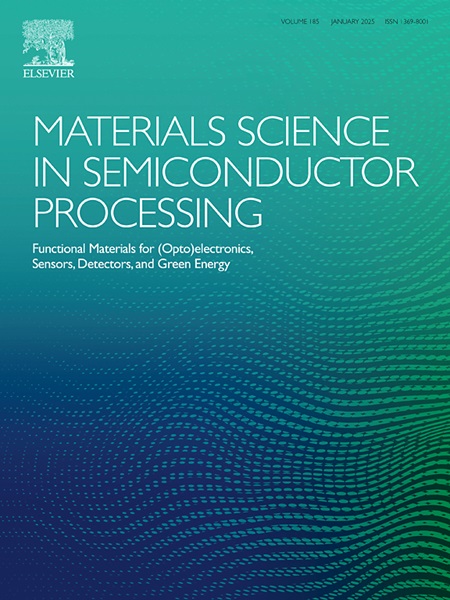Analog switching and retention modulation in stack-designed InGaZnO memristors for neuromorphic systems
IF 4.6
3区 工程技术
Q2 ENGINEERING, ELECTRICAL & ELECTRONIC
引用次数: 0
Abstract
In this study, three types of IGZO-based analog memristors (Mo/IGZO/Pd: S1, Mo/Al2O3/IGZO/Pd: S2, Pd/IGZO/SiO2/p+-Si: S3) were designed to exhibit distinct switching mechanisms and key electrical characteristics for synaptic device applications. A comprehensive analysis was conducted using I-V curve analysis and energy band diagrams to examine conduction mechanisms and Schottky barrier modulation. During the set and reset operations of S1 and S2, as well as the set operation of S3, electron transport over the Schottky barrier is governed by thermionic emission. However, in the reset operation of S1, incomplete VO2+ neutralization hinders barrier recovery, enabling alternative conduction paths and resulting in ohmic-like behavior. Unlike abrupt switching driven by the formation and rupture of conductive filaments (CFs), the IGZO-based memristors demonstrated gradual switching behavior via Schottky barrier (ϕB) modulation. The retention, endurance, linearity, and conductance state characteristics of each device were quantitatively evaluated. Among the three devices, S3 exhibited superior retention and endurance characteristics compared to the other devices, along with a larger number of conductance states. Furthermore, the S3 device demonstrated outstanding pattern recognition performance, achieving a high accuracy of 95.31 % when tested with the MNIST database, which is attributed to its robust retention properties. This study presents a systematic comparison of IGZO-based analog memristors fabricated under identical process conditions, highlighting how stack configuration and electrode choice affect switching mechanisms and neuromorphic performance. Notably, These results suggest that S3 could be a promising candidate for synaptic devices in neural network systems due to its analog switching characteristics, high retention, and endurance properties.
神经形态系统中堆叠设计InGaZnO忆阻器的模拟开关和保持调制
在本研究中,设计了三种基于IGZO的模拟忆阻器(Mo/IGZO/Pd: S1, Mo/Al2O3/IGZO/Pd: S2, Pd/IGZO/SiO2/p+-Si: S3),以展示不同的开关机制和关键的电特性,用于突触器件应用。利用I-V曲线分析和能带图对传导机制和肖特基势垒调制进行了综合分析。在S1和S2的设置和重置操作以及S3的设置操作中,电子在肖特基势垒上的传递受热离子发射的控制。然而,在S1的复位操作中,不完全的VO2+中和阻碍了势垒的恢复,从而实现了替代的传导路径并导致了类欧姆行为。与由导电丝(CFs)的形成和断裂驱动的突然开关不同,基于igzo的忆阻器通过肖特基势垒(b)调制表现出逐渐的开关行为。定量评价了每个器件的保持、持久、线性和电导状态特性。在这三种器件中,S3表现出比其他器件更好的保持和持久特性,以及更多的电导状态。此外,S3设备表现出出色的模式识别性能,在与MNIST数据库进行测试时,其准确率高达95.31%,这归功于其强大的保留特性。本研究系统比较了在相同工艺条件下制造的基于igzo的模拟忆阻器,强调了堆栈配置和电极选择如何影响开关机制和神经形态性能。值得注意的是,这些结果表明S3可能是神经网络系统中突触器件的一个有希望的候选者,因为它具有模拟开关特性,高保留和持久特性。
本文章由计算机程序翻译,如有差异,请以英文原文为准。
求助全文
约1分钟内获得全文
求助全文
来源期刊

Materials Science in Semiconductor Processing
工程技术-材料科学:综合
CiteScore
8.00
自引率
4.90%
发文量
780
审稿时长
42 days
期刊介绍:
Materials Science in Semiconductor Processing provides a unique forum for the discussion of novel processing, applications and theoretical studies of functional materials and devices for (opto)electronics, sensors, detectors, biotechnology and green energy.
Each issue will aim to provide a snapshot of current insights, new achievements, breakthroughs and future trends in such diverse fields as microelectronics, energy conversion and storage, communications, biotechnology, (photo)catalysis, nano- and thin-film technology, hybrid and composite materials, chemical processing, vapor-phase deposition, device fabrication, and modelling, which are the backbone of advanced semiconductor processing and applications.
Coverage will include: advanced lithography for submicron devices; etching and related topics; ion implantation; damage evolution and related issues; plasma and thermal CVD; rapid thermal processing; advanced metallization and interconnect schemes; thin dielectric layers, oxidation; sol-gel processing; chemical bath and (electro)chemical deposition; compound semiconductor processing; new non-oxide materials and their applications; (macro)molecular and hybrid materials; molecular dynamics, ab-initio methods, Monte Carlo, etc.; new materials and processes for discrete and integrated circuits; magnetic materials and spintronics; heterostructures and quantum devices; engineering of the electrical and optical properties of semiconductors; crystal growth mechanisms; reliability, defect density, intrinsic impurities and defects.
 求助内容:
求助内容: 应助结果提醒方式:
应助结果提醒方式:


